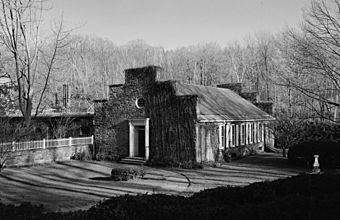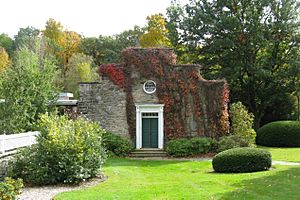Crane and Company Old Stone Mill Rag Room facts for kids
|
Crane and Company Old Stone Mill Rag Room
|
|
|
U.S. Historic district
Contributing property |
|

HABS photo, 1988
|
|
| Location | Dalton, Massachusetts |
|---|---|
| Built | 1844 |
| Architect | Zenas Crane |
| Part of | Cranesville Historic District (ID05001208) |
| NRHP reference No. | 83004376 |
Quick facts for kids Significant dates |
|
| Added to NRHP | July 1, 1983 |
| Designated CP | November 9, 2005 |
The Crane and Company Old Stone Mill Rag Room is a very old building. It was built in 1844. It belongs to Crane & Co., a company that makes paper. Crane & Co. is one of the oldest paper businesses in Berkshire County, Massachusetts. The building is in Dalton. People have made paper on this spot since the early 1800s.
The Rag Room was first used to prepare rags for making paper. Since 1930, it has been home to the Crane Museum of Papermaking. This special building was named a National Historic Landmark in 1983.
Zenas Crane started making paper in Dalton in 1801. He took full control of the paper-making site in 1822. His sons built the Old Stone Mill in the mid-1840s. The Rag Room is the only part of that mill still standing today.
Zenas Crane's grandson, Winthrop Murray Crane, learned the paper business here. Thanks to him, Crane & Co. got a special deal. They became the only company to make paper for the money used in the United States. They still do this important job today!
The Rag Room is a gray building made of stone. It has a roof made of slate. Inside, it is one big open space. This space holds displays and old items from the company's history.
Contents
The Story of Crane Paper
How Paper Making Began in Dalton
Zenas Crane (1777–1845) learned how to make paper from his brother. His brother owned a paper mill in Newton Lower Falls, Massachusetts. After working at another mill, Zenas traveled to Berkshire County in 1799. He was looking for a good place to start his own paper mill.
He found a perfect spot in Dalton. But the farmer who owned the land did not want to sell it. So, Zenas started his business on a nearby piece of land in 1801. Other paper makers also came to the area. Henry Wiswell and David Carson bought the better spot. They built what was called the Red Mill. Zenas Crane eventually bought the Red Mill. He owned it completely by 1822.
Building the Stone Mill
In 1842, Zenas Crane stopped working. He gave control of the Red Mill to his sons. Their names were Zenas Marshall Crane and James Brewer Crane. They started Crane & Co.. They wanted to make the business bigger. So, they began building a new mill called the Stone Mill. The Rag Room was part of this new building. It was finished in 1844.
In 1869, the Stone Mill was damaged by a fire. While it was being fixed in 1870, the Red Mill burned down. The Stone Mill was then made larger. It became known as the Pioneer Mill. Crane & Co. used the Stone Mill until the 1890s. Most of it was then torn down, leaving only the Rag Room.
The Rag Room Becomes a Museum
In 1930, the company decided to turn the Rag Room into a museum. It has been the company museum ever since. An architect named Charles S. Keefe helped with the plans. The company made the building's foundation stronger with steel and concrete. They also filled in some of its windows with stone.
The inside of the building was changed a lot. New wooden parts and floors were added. When it was finished, the inside looked like the Old Ship Church in Hingham, Massachusetts. In 1967, a company called Olmsted Brothers designed the outdoor areas. The Rag Room was named a National Historic Landmark in 1983. It was also added to the National Register of Historic Places. In 2005, it became part of the Cranesville Historic District. This district includes Zenas Crane's home, built in 1816.
A Future Governor Learns the Business
The Rag Room was where Winthrop Murray Crane (1853–1920) started his career. He was Zenas Marshall Crane's son. In 1878, he helped Crane & Co. get a very important deal. They became the only company allowed to make the special paper for United States money.
Besides running Crane & Co., Murray Crane also became the Governor of Massachusetts. He later served as a United States Senator. He was a very important person in the Republican Party.
What the Rag Room Looks Like
The Rag Room is a single-story building. It is made of gray stone. It has three windows on the short side and seven windows on the long side. The roof is made of slate. It used to be connected to the larger Stone Mill buildings on its north side. This building was where rags were prepared. This was the first step in making paper.
In 1930, a proper entrance was added to the north side. It has special doors with small windows above them. There are also Doric columns below a sign that says "Crane Museum." A round window was also added above this doorway. The slate roof and its support beams were replaced in 1930. But the outside of the building still looked the same.
A brick part was added to the east side in the late 1800s. This part is not included in the landmark status. It is hidden by plants. The inside of the building is one large room. It shows old tools and other items from the company's history. There is even a copy of the old equipment used to make paper.
The museum is currently closed.
More to Explore





